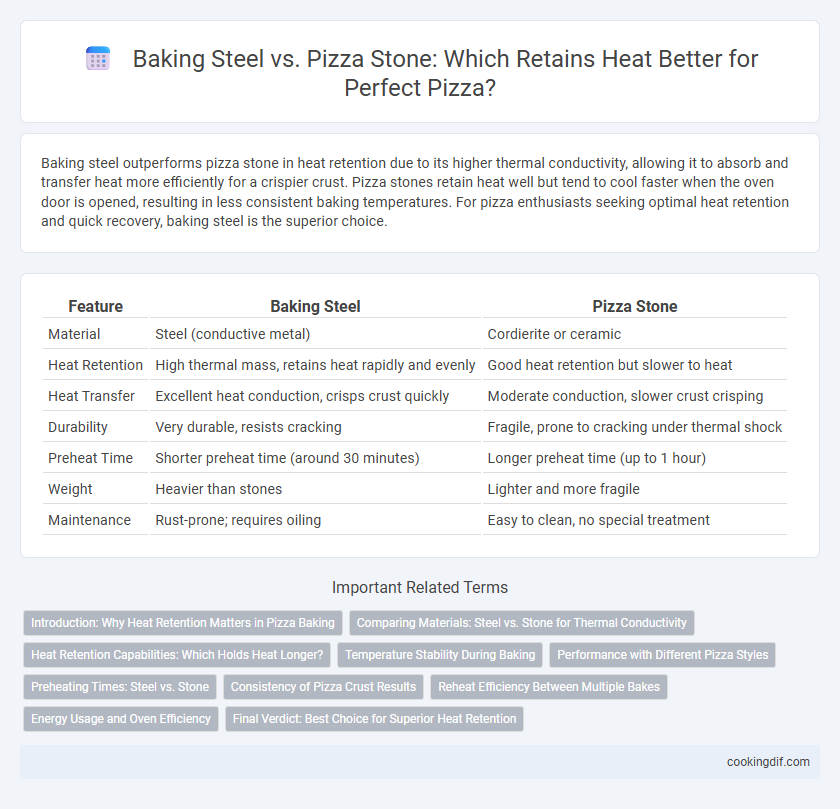Baking steel outperforms pizza stone in heat retention due to its higher thermal conductivity, allowing it to absorb and transfer heat more efficiently for a crispier crust. Pizza stones retain heat well but tend to cool faster when the oven door is opened, resulting in less consistent baking temperatures. For pizza enthusiasts seeking optimal heat retention and quick recovery, baking steel is the superior choice.
Table of Comparison
| Feature | Baking Steel | Pizza Stone |
|---|---|---|
| Material | Steel (conductive metal) | Cordierite or ceramic |
| Heat Retention | High thermal mass, retains heat rapidly and evenly | Good heat retention but slower to heat |
| Heat Transfer | Excellent heat conduction, crisps crust quickly | Moderate conduction, slower crust crisping |
| Durability | Very durable, resists cracking | Fragile, prone to cracking under thermal shock |
| Preheat Time | Shorter preheat time (around 30 minutes) | Longer preheat time (up to 1 hour) |
| Weight | Heavier than stones | Lighter and more fragile |
| Maintenance | Rust-prone; requires oiling | Easy to clean, no special treatment |
Introduction: Why Heat Retention Matters in Pizza Baking
Heat retention plays a crucial role in achieving the perfect pizza crust, influencing cooking time and texture. Baking steel offers superior thermal conductivity and maintains higher temperatures longer than pizza stone, ensuring consistent heat distribution. Pizza stones, typically made from ceramic or cordierite, absorb heat well but cool down faster, which can affect crust crispiness and overall bake quality.
Comparing Materials: Steel vs. Stone for Thermal Conductivity
Baking steel outperforms pizza stone in thermal conductivity, reaching higher temperatures more quickly and retaining heat longer, which results in evenly cooked, crispy crusts. Steel's superior heat transfer enhances browning and creates optimal conditions for achieving pizzeria-quality pizza at home. While stone absorbs heat well, it cools faster and heats more unevenly compared to steel, making steel the preferred choice for consistent heat retention and faster cooking times.
Heat Retention Capabilities: Which Holds Heat Longer?
Baking steel retains heat significantly longer than traditional pizza stones due to its higher thermal conductivity and density, allowing it to maintain consistent temperatures for extended baking sessions. Pizza stones, typically made from ceramic or cordierite, absorb heat but cool down faster because of their porous structure. For chefs seeking optimal heat retention to achieve crispier crusts and evenly cooked pizzas, baking steels offer superior performance in maintaining stable oven temperatures.
Temperature Stability During Baking
Baking steel outperforms pizza stone in temperature stability during baking due to its higher thermal conductivity and density, allowing it to retain and transfer heat more efficiently. This results in consistent and even cooking, producing a crispy crust without temperature fluctuations between batches. Pizza stones, while effective, cool down faster and require longer recovery time, impacting heat retention and overall baking performance.
Performance with Different Pizza Styles
Baking steel offers superior heat retention and faster heat transfer compared to pizza stones, making it ideal for achieving crispy, well-cooked crusts in Neapolitan and New York-style pizzas. The steel's higher thermal conductivity ensures consistent baking temperatures, crucial for thin-crust pizzas that require quick, intense heat. Conversely, pizza stones excel with thicker, rustic styles like Sicilian or deep-dish, where slower, even heat helps develop a tender, golden crust without burning.
Preheating Times: Steel vs. Stone
Baking steel heats up significantly faster than pizza stone, often reaching optimal cooking temperatures in about 30 to 45 minutes, compared to the 45 to 60 minutes required for pizza stone preheating. The higher thermal conductivity of steel provides more rapid and consistent heat transfer, which improves heat retention during baking. This faster preheat time and efficient heat retention contribute to achieving a crispier crust and more evenly cooked pizza.
Consistency of Pizza Crust Results
Baking steel offers superior heat retention and faster recovery times compared to pizza stone, ensuring consistent oven temperature throughout the baking process. This stability results in evenly cooked pizza crusts with a perfect balance of crispiness and chewiness on every pie. Pizza stones, while effective, often struggle with heat loss and slow recovery, which can lead to inconsistent crust textures during multiple bakes.
Reheat Efficiency Between Multiple Bakes
Baking steel outperforms pizza stone in heat retention, allowing for faster reheating between multiple bakes due to its higher thermal conductivity and density. Steel's ability to absorb and transfer heat efficiently maintains a more consistent temperature, minimizing downtime between pizzas. Pizza stones, while effective, cool down more quickly after each bake, requiring longer recovery time and reducing reheat efficiency.
Energy Usage and Oven Efficiency
Baking steel offers superior heat retention compared to pizza stones, allowing ovens to maintain higher temperatures with less continuous energy input. Its high thermal conductivity ensures faster heat transfer to the pizza, improving oven efficiency by reducing preheat and baking times. This efficiency translates to lower energy consumption, making baking steel a more energy-conscious choice for consistent, high-quality pizza cooking.
Final Verdict: Best Choice for Superior Heat Retention
Baking steel outperforms pizza stone in heat retention due to its higher thermal conductivity and density, allowing it to maintain consistent, intense heat essential for crispy, evenly baked crusts. Pizza stones, typically made from ceramic or cordierite, heat more slowly and lose heat faster, which can result in longer baking times and less optimal crust texture. For superior heat retention and efficient baking performance, baking steel is the best choice for serious home bakers and pizza enthusiasts.
Baking steel vs pizza stone for heat retention Infographic

 cookingdif.com
cookingdif.com